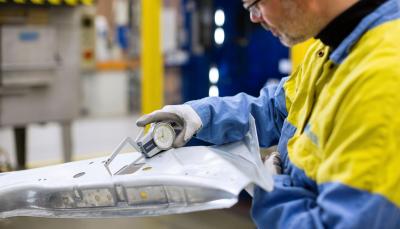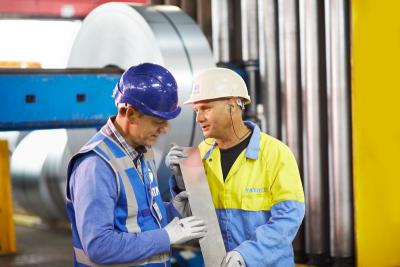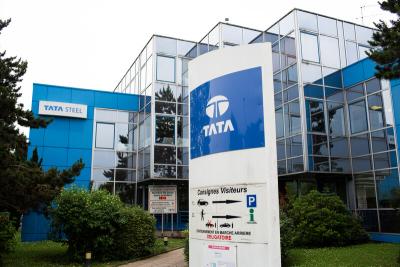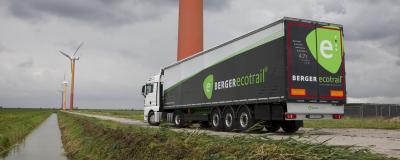- What is an EPD?
- As a client, what benefit does an EPD provide?
- Why are Tata Steel producing EPD’s?
- How are EPD's produced?
- Can Tata Steel offer any other EPD's such as project specific EPD's?
- What kind of information is included in EPD's?
- Are there different types of EPD?
- What EPD standards exist and do Tata Steel EPD's comply?
- Are Tata Steel EPD's externally verified and what "Type" are they?
- Do Tata Steel EPD’s help our customers accrue points under building certification schemes like LEED and BREEAM?
- What else should our customers be thinking about when considering EPD’s?
- How often are EPD’s reviewed and replaced?
What is an EPD?
An Environmental Product Declaration (EPD) is a standardised way of quantifying the environmental impact of a product or system. It allows our clients and stakeholders to see the impacts associated with the sourcing, the production and the delivery of a product. It also captures the end-of-life scenarios associated with when the building comes to the end of its life and what might happen with the building products.
As a client, what benefit does an EPD provide?
There are a range of reasons why a client may want an EPD;
- For use in vendor qualifications (for building evidence of a responsible supply chain for example).
- To help developers or owners accrue points under building certification schemes such as BREEAM and LEED. Up to 1.5 points are available in BREEAM and 1 full point in LEED, for provision of EPD’s of building products.
- For infrastructure projects that require Environmental Assessments under the Town and Planning Act (2017)[1], EPD’s and life cycle assessments can provide valuable information.
Often clients require EPD’s because their clients are asking for them, and there are minimum requirements for reporting within their chosen supply chains.
Why are Tata Steel producing EPD’s?
Tata Steel values include ‘responsibility’ and ‘integrity’ which drive our behaviour and ambition. We have an ambition to be acknowledged as leaders in sustainability in construction markets therefore the transparency and reporting that EPD’s provide are very much aligned to that. Other work like our Responsible Sourcing Certification[2] supports this ambition also.
Tata Steel also have the capability, with world class life cycle assessment skills, which has enabled it to become the world’s first steel company to operate an EPD Programme to ISO standards.
How are EPD’s produced ?
EPD’s are based upon Life Cycle Assessments (LCA) of a product or system. An LCA is an ‘audit’ of the environmental impact of a product through its life cycle (from raw materials, through production and transport to site and then at the end of its life eg reuse, recycling or disposal). Typically EPD’s are not able to record the impact of the ‘use’ phase of a products lifecycle due to the variety of uses a product can be put to, but this will depend upon the product in question.
The LCA is produced using data related to the manufacture of the product, such as the resources used and waste/emissions generated. This is combined with data associated with the transport of the product (usually an ‘average scenario’ as the destination is unknown) along with the impact of what will happen to that product at the end of its life (e.g. reuse, recycling or disposal[3]).
Sources of data include Tata Steel’s own manufacturing site data. This will detail resource use, wastes and emissions. For the life cycle data for the materials that we import on to our sites , for example packaging materials, when specific data is not available then generic data in the standard LCA software can be used in compliance with the relevant standards.
Can Tata Steel offer any other EPD’s such as project specific EPD’s?
As well as producing product specific EPD’s, Tata Steel are aiming to increase the transparency and accuracy of EPD reporting and have developed a number of EPD tools. These tools, for certain product groups, provide clients with EPDs which are tailored to their specific scope of work and specification. This is a unique global reporting offering and supports Tata Steel’s ambition of acknowledged leadership in sustainability in construction markets.
What kind of information is included in EPD’s?
Where EPD’s comply with ISO standards then the EPD’s will contain a minimum and prescribed set of data and information. Whilst EPD’s do vary in format they will typically include a description of the product, technical data and product specification, manufacturing description, LCA methodology and the results of the LCA, including an interpretation of those results. Impact data such as carbon emissions, water use and so on, are included in the EPD results.
Are there different types of EPD ?
Yes there are, some EPD’s can be generic and include multiple supply chains for a given product. An example of this is an industry body sponsoring an industry EPD for their members – this would involve collecting data from each of their members and producing an EPD which is an average of that data.
Conversely there are product specific EPD’s. Tata Steel EPD’s are product specific EPD’s. Product specific EPD’s tend to be valued more by building certification schemes such as BREEAM or LEED, and by clients, due to their increased accuracy and specificity. For example average EPD’s might contribute to a quarter of one point in LEED but specific EPD’s might contribute a full point. In BREEAM the equivalent scores would be 0.5 points up to 1.5 points.
To contribute to the maximum number of relevant points within building certification schemes, EPD’s need to be externally verified to standards such as EN15804. This means that an independent, qualified third party reviews the EPD and confirms its validity, which is then certified as ‘externally verified’. Some EPD’s are produced that don’t undertake that 3rd party verification and are worth less points in building certification schemes.
Tata Steel EPD’s are 3rd party externally verified.
What EPD standards exist & do Tata Steel EPD’s comply ?
Some relevant standards for EPDs are:
- The ISO 14040 and ISO 14044 Life Cycle Assessment standards.
- The ISO 14025 Type III Environmental Declarations standard.
- The EN 15804 and ISO 21930 Sustainability in Building Construction standards.
Tata Steel EPD’s do comply with these standards.
Are Tata Steel EPD’s externally verified and what “Type” are they?
To contribute to points within building certification schemes, EPD’s need to be externally verified to standards such as EN 15804. This means that an independent, qualified party reviews the EPD and confirms its validity which is then certified as externally verified. Some EPD’s are produced that don’t undertake that 3rd party verification.
Tata Steel EPD’s are 3rd party externally verified, Type III EPD’s and Tata Steel’s EPD programme complies with the relevant ISO standards.
Do Tata Steel EPD’s help our customers accrue points under building certification schemes like LEED and BREEAM ?
Yes and Tata Steel EPD’s are of the type that help accrue a greater number of points as they are externally verified and product specific. See the table below for a summary of EPD points under BREEAM & LEED.
|
Example Scheme
|
EPD Type
|
Requirement
|
Points available
|
|
BREEAM[4]
|
More than one product (from one product group) and more than one manufacturer
|
ISO 14025 Operator issued EPD’s
|
0.5
|
|
More than one product (from one product group) and one manufacturer
|
EPD generated with product category rules based on EN 15805 or ISO 21930
|
0.75
|
|
Single product and single manufacturer (potentially manufactured in more than one location
|
EPD generated with product category rules based on EN 15805 or ISO 21930
|
1.5
|
|
LEED[5]
|
Publically available, critically reviewed
|
ISO 14044 at least cradle to gate
|
0.75
|
|
Industry wide (manufacturer named) externally verified
|
ISO 14025, 14040, 14044 and EN 15804 or ISO 21930
|
0.5
|
|
Product Specific externally verified
|
ISO 14025, 14040, 14044 and EN 15804 or ISO 21930
|
1.0
|
What else should our customers be thinking about when considering EPD’s ?
EPD’s are important to understand the environmental impacts of a product or system throughout its life cycle however they cannot be considered on their own. They should be part of a holistic approach to building design to minimise the impact of the asset or building in all phases of the lifecycle. Other factors which will contribute to improved sustainability include a focus on ‘in use’ application. For example the integration and use of renewables and a focus on products which deliver air tight solutions with requisite levels of insulation can all be important factors at the design stage.
The detailing including lighting and reflective surfaces all need to be considered in balance with the needs/purpose of the space. It is no coincidence that such considerations are typically rewarded under building certification schemes and, in addition to our EPD offering, Tata Steel are also able to offer products, services and advice in this regard.
In order to make the right resource decisions we need to consider not only the manufacture of the product but the whole life cycle[6]. Only by taking this life cycle approach can the optimum resource decisions be made. Steel is a very sustainable product when the complete Life cycle is considered as steel is durable and long lasting and, at the end of its life, could be reused and is almost always recycled.
How often are EPD’s reviewed and replaced?
In accordance with standards, EPD’s are typically valid for a period of 5 years from creation. However in the event that there is a change which will impact upon the results of the EPD then a revision will need to be made. As part of the Tata Steel EPD Programme, and in line with relevant standards, a process to assess (annually) any changes to production or supply is assessed for impact upon the result of the EPD. If the impact is consider significant then the EPD will be adjusted and reissued.
EPD’s seem like quite a technical document – do I need to be able to interpret it?
EPD’s are technical sustainability documents and interpreting and understanding them often requires a sustainability professional. Tata Steel are able to support our customers and stakeholders in this and we are able to provide further information and advice on the use of EPD’s.
If you have any questions please contact your local Tata Steel contact or email Barry Rust, Sustainability Manager for Tata Steel: [barry.rust@tatasteeleurope.com]
Notes:
[1] UK legislation which increases requirements for upfront (planning) assessment of environmental impacts.
[2] Tata Steel have the widest portfolio of products certified as responsibly sourced against the Building Research Establishment British Environmental Specification (BES) 6001.
[3] Note that for steel, as opposed to many other materials, the impact at the end of life is positive as steel is typically reused or recycled, due to its durability, flexibility and the value of scrap steel.
[4] BREEAM 2018.
[5] LEED Version 4.
[6] Some EPD’s do not include end of life scenarios and therefore ignore an important part of the lifecycle.


























































